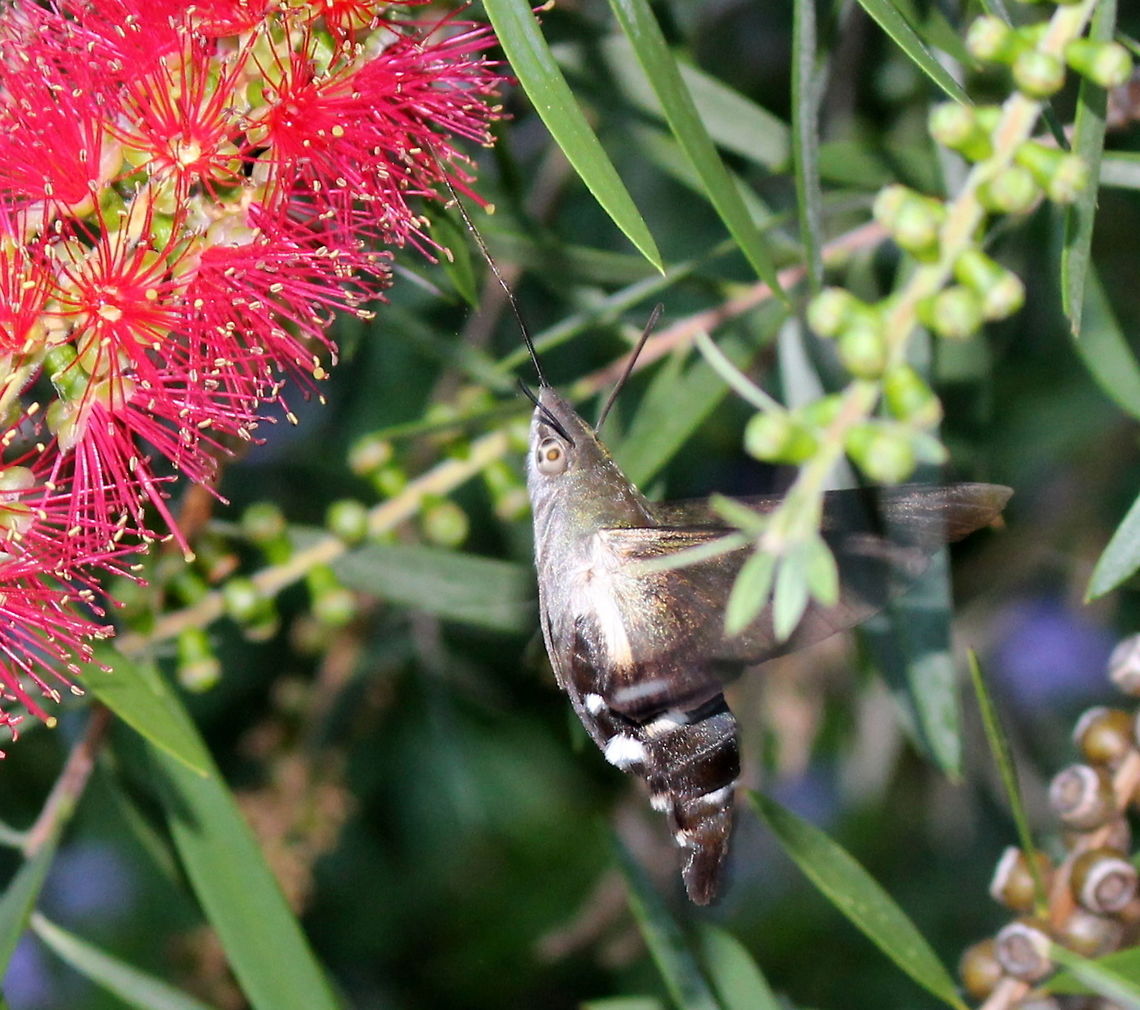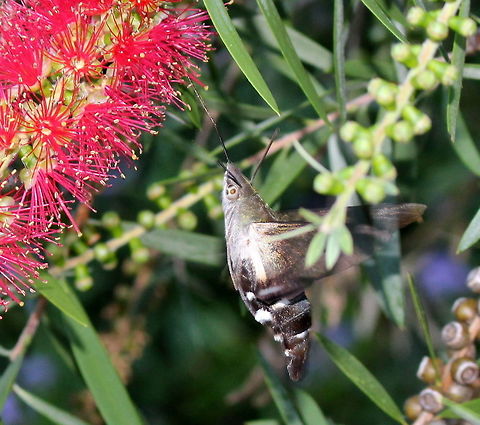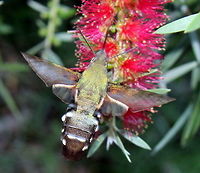 PromotedSpecies introCountry intro
PromotedSpecies introCountry intro
Australian Hummingbird Hawkmoth, Macroglossum micacea, Wilkesdale, SE QLD, Australia
About two weeks ago I have experienced something out of my ordinary. I was talking to a friend in her garden at around 6 pm, and as we stood by a red bottle brush (Callistemon), we heard a very loud buzzing sound. The larger than normal pollinator hovered with it’s extremely rapidly beating wings near the flowers. It was just like a tiny hummingbird! We were so intrigued, we almost got fooled, but I knew that unfortunately, we do not have hummingbirds in Australia.
I started craving for my camera. Soon my friend brought out her brand new Cannon hoping to maybe get a shot of this fascinating little creature, so we could get a closer look. As we have suspected this fantastic, hovering beauty was a hawkmoth. I was determined to get a closer pic and was very glad when my friend handed me her camera. I followed the very adamant creature trying to capture it’s beauty on camera. It was fast and I just stood there mesmerised by its disposition.
After some time it seemed to have become accustomed to my prying presence and began to ignore me, completing it’s seemingly one pointed mission, as I ecstatically snapped away. I could have stayed there for ever, I did not want this experience to ever end. After a while though, it was time for me to leave this impressive experience behind. As I walked away, I hoped that at least some of the photos would turn out, so I can identify the creature and perhaps share its beauty with others.
I asked my friend if I could borrow her SD card to copy the images onto my computer. I could not believe the treasure I have acquired. I felt so much joy, just like an excited child who has just received a brand new toy, or better yet a brand new puppy!
Thus photo shows it's iridescent blue, yellow and green colours:
I have spent days trying to identify this moth as there are no other live photos of this species online. I'm still waiting for replies from entomologists. I have downloaded some fascinating science articles on moth vision and here is a summary:
Hummingbird moths are actually diurnal species, meaning that they forage during the day. Besides using olfactory or scent senses, they have cololour or chromatic vision to identify their food source. Additionally they also use achromatic cues such as intensity of contrast or brightness to identify their preferred nectar sources. Like us and bees, they also use colour constancy, the ability to recognise a specific colour regardless of the illumination, which may change the shade or intensity of a colour. However, unlike us and bees, who are colourblind at night, nocturnal moths are able to discriminate flowers at starlight intensity. Moths, like us, bees and other animals learn to distinguish colours and can be trained to do so, if given a sweet reward.
I wrote an article about The Exhilarating Encounter with a Hummingbird Moth, my trials to identify it and with more images of this beautiful creature on the Pollinator Link site https://pollinatorlink.wordpress.com/2015/02/16/the-exhilarating-encounter-with-a-hummingbird-moth/
I will post the article of the biology of Hummingbird Hawkmoth vision at https://pollinatorlink.wordpress.com shortly.
Thanks for this awesome opportunity to share our creatures.

''Macroglossum micacea'' is a moth of the Sphingidae family. It is known from the Solomon Islands, the D'Entrecasteaux Islands, Papua New Guinea and Queensland.
The wingspan is about 50 mm. Adults have dark brown forewings, sometimes with indistinct paler bands across them. They have even darker brown hindwings with two yellow areas by the inner margin.


comments (6)
I have to say, I'm deeply impressed. Us moderators normally need to put a lot of time in educating new members in how to share their photos here, to includes species info, location info, etc.
And here you come with your first photo, shared in a spectacular way. With all data included, deep background, persistence in finding the correct species, all of it. You're setting a very high standard here. You are exactly the kind of member we need, so again....welcome, friend of nature.
And regarding the photo, amazing, and a species intro...the most valuable action one can do on the site! Posted 10 years ago
thank you so much for the lovely welcome and the honour. I did not expect this and it was an absolute pleasure to have the opportunity to share this with other nature lovers :)
I would love to post more pics for this species to show it's full beauty and colours. Do I need to post them separately or is there a way to upload more to with this post?
Thank you so much once again, it's definitely inspired me to keep going along with what I love the most, getting to know all the creatures great and small :)
Posted 10 years ago
http://www.jungledragon.com/specie/5416/photos
The above link is what you get when clicking the photo icon in the right species pane. It currently has one photo, but any photo identifying this species will automatically appear there.
If you wish, you can also make references to those other photos directly inside the description of this photo or in a comment. It's as easy as pasting the URL of that other photo here. Check out this example by another member who has built a full story in the description, referencing several other photos:
You can also include tags, videos, users and photo lists that way. In small text below the "post comment" button there is some help text that explains how.
I hope this helps!
Posted 10 years ago